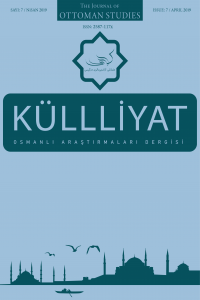Öz
Muhammed
Mazlumzâde el-Hasekî is a 17th century scholar. As he mentioned in the
introduction of his book called Tefsir-i Cüz-i Nebe which he wrote in Ottoman
Turkish, he is an Ottoman statesman and intellectual who completed his
education in Enderun. Quranic exegesis being his main field, he was active in
different fields of Islamic science. Tefsir-i Cüz’i Nebe is the only written
work of him that we have today. There isn’t much information about his life in
historical resources. The research that we are working on is about one of his
works that deal with the Quran’s last part called Amme. In this research of the
30th juz of the Quran, we indicated Meccan and Medinian surahs, numbers of the
words and letters of ayats, dictionary meanings of some words and different
recitation styles of the imams of kiraat. As well as this, the information on
the revelation reasons, sayings of sahabe and tabiun are some aspects of riwaya
in the exegesis. As well as narrating from exegetes like Zemahşerî, Kevâşî,
Beydâvî, Beğâvî and Sülemî, there are narrations with phrases like “some
exegetes” or “most exegetes” without mentioning any name. In the research, the
method of exegesis was studied, both riwaya and diraya methods are present.
However, it was obvious that riwaya method is used more in this work.
Anahtar Kelimeler
Exegesis Mazlumzâde el-Hasekî Tefsir-i Cüz-i Nebe Ottoman Exegetes
Kaynakça
- ABAY, Muhammed (1999). Osmanlı Döneminde Yazılan Tefsirler ile ilgili Eserler Bibliyografyası: Divan Dergisi, ATAY, Hüseyin (1983). Osmanlılarda Yüksek Din Eğitimi. İstanbul: Dergâh Yayınları.Aydar, Hidayet (2017). 17. Asır Osmanlı Tefsir Hareketine Panoramik Bakış. İstanbul: Cerrahoğlu, İsmail (2013). Tefsir Usûlü. ANKARA: TDV yayınları.Muhammed Mazlumzâde. Tefsir-i Cüz’i Nebe. Süleymaniye Kütüphanesi. Hasan Hüsnü Paşa. No: 52.Muhammed Mazlumzâde. Tefsir-i Cüz’i Nebe. Süleymaniye Kütüphanesi. Hacı Mahmud Efendi. No: 265.Muhammed Mazlumzâde. Tefsir-i Cüz’i Nebe. İstanbul Üniversitesi Nadir Eserler Kütüphanesi. Türkçe Yazmalar. No: 7301.Öztürk, Mustafa (2015). Osmanlı Tefsir Mirası. Ankara: Ankara Okulu.
Öz
17. yy.
âlimlerinden Muhammed Mazlumzâde el-Hasekî, Tefsir-i Cüz-i Nebe isimli Osmanlı
Türkçesi ile kaleme aldığı eserinin mukaddimesinde belirttiği üzere tahsilini
Enderun’da ikmal etmiş bir Osmanlı devlet adamı ve aydınıdır. Başta tefsir
olmak üzere bir çok ilim alanında hizmet etmiştir. Fakat kayıtlarda günümüze
ulaşan başka eseri bulunmamaktadır. Hayatı hakkında kaynaklarda pek bilgi bulunmamaktadır.
Üzerinde çalıştığımız yazma eseri, Kur’ân’ın son cüzü olan Amme cüzünü kapsayan
bir çalışmasıdır. Çalışmada, 30. cüzde mevcut olan sûrelerin Mekkî-Medenî
bilgisi, ayetlerin kelime ve harf sayıları, bazı kelimelerin lügavî manaları ve
kırâat imamlarının farklı okuyuşları belirtilmiştir. Yine, esbâb-ı nüzûl
bilgileri, sahâbe ve tabiûn kavilleri tefsirde bulunan rivâyet unsurlarından
bazılarıdır. Ayrıca eserde Zemahşerî, Kevâşî, Beydâvî, Beğâvî ve Sülemî gibi
müfessirlerden nakillerin yanında, “bazı müfessirîn” veya “ekserî müfessirîn”
gibi ifadelerle isim verilmeden de nakiller yapılmıştır. Çalışmada, tefsirin
metodu incelenmiş rivâyet ve dirâyet yönünden zengin olduğu, ancak rivâyet yönü
ön planda olan tefsirlerden olduğu görülmüştür.
Anahtar Kelimeler
Mazlumzâde el-Hasekî Tefsir-i Cüz-i Nebe Osmanlı Müfessirleri Tefsir
Kaynakça
- ABAY, Muhammed (1999). Osmanlı Döneminde Yazılan Tefsirler ile ilgili Eserler Bibliyografyası: Divan Dergisi, ATAY, Hüseyin (1983). Osmanlılarda Yüksek Din Eğitimi. İstanbul: Dergâh Yayınları.Aydar, Hidayet (2017). 17. Asır Osmanlı Tefsir Hareketine Panoramik Bakış. İstanbul: Cerrahoğlu, İsmail (2013). Tefsir Usûlü. ANKARA: TDV yayınları.Muhammed Mazlumzâde. Tefsir-i Cüz’i Nebe. Süleymaniye Kütüphanesi. Hasan Hüsnü Paşa. No: 52.Muhammed Mazlumzâde. Tefsir-i Cüz’i Nebe. Süleymaniye Kütüphanesi. Hacı Mahmud Efendi. No: 265.Muhammed Mazlumzâde. Tefsir-i Cüz’i Nebe. İstanbul Üniversitesi Nadir Eserler Kütüphanesi. Türkçe Yazmalar. No: 7301.Öztürk, Mustafa (2015). Osmanlı Tefsir Mirası. Ankara: Ankara Okulu.
Ayrıntılar
| Birincil Dil | Türkçe |
|---|---|
| Konular | Din Araştırmaları |
| Bölüm | İlahiyat |
| Yazarlar | |
| Yayımlanma Tarihi | 23 Nisan 2019 |
| Gönderilme Tarihi | 27 Şubat 2019 |
| Kabul Tarihi | 15 Nisan 2019 |
| Yayımlandığı Sayı | Yıl 2019 Sayı: 7 |


